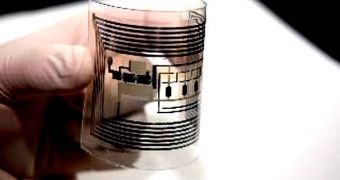One of the major inconveniences in today's shopping malls is the queue at the end of the run. People spend a large amount of time waiting at the check-out stands, as those in front appear to be purposefully moving slower. But this hassle could soon become history, thanks to a new device invented by an international scientific collaboration.
Researchers from the Rice University joined forces with colleagues from the Sunchon National University, in South Korea, to develop advanced RFID tag chips. These new instruments could be inconspicuously inserted into any product, and would allow for the customer to simply walk out of the store by passing through a scanner. The machine would automatically determine the products contained inside, sum up their cost, charge that individual's bank account, and also subtract the products from the store's inventory. It's safe to say that everyone would be better off, the Rice experts say.
The inexpensive, printable transmitter is not some distant proposal, but something that could readily be manufactured today. It could theoretically fit into any style of package, including that of fruit and perishable foods. According to the team behind the device, it could be possible to envision more advanced systems as well that would keep track of where all products in a store are at all times. Details of how the chips work are published in print, in the March issue of the journal IEEE Transactions on Electron Devices.
“We are going to a society where RFID is a key player,” expert and team leader Gyou-jin Cho, who is a professor of printed electronics engineering at Sunchon, says. He adds that the new technology will most likely take an additional five years or so to fully mature. However, stripped-down versions of the new RFID chips could be made commercially available even sooner. In a bid to bring the already low production costs even lower, Cho and his team are working on two fronts. They are perfecting the chips, and also setting the foundation of a new roll-to-roll printing process that could make creating the RFID tags even easier.
“Right now, the emitter has to be pretty close to the tags, but it's getting farther all the time. The practical distance to have it ring up all the items in your shopping cart is a meter. But the ultimate would be to signal and get immediate response back from every item in your store – what's on the shelves, their dates, everything. At 300 meters, you're set – you have real-time information on every item in a warehouse. If something falls behind a shelf, you know about it. If a product is about to expire, you know to move it to the front – or to the bargain bin,” Rice Professor of Mechanical Engineering and Materials Science, and of Computer Science James Tour says. He is also the T.T. and W.F. Chao Chair in Chemistry at the university.

 14 DAY TRIAL //
14 DAY TRIAL //